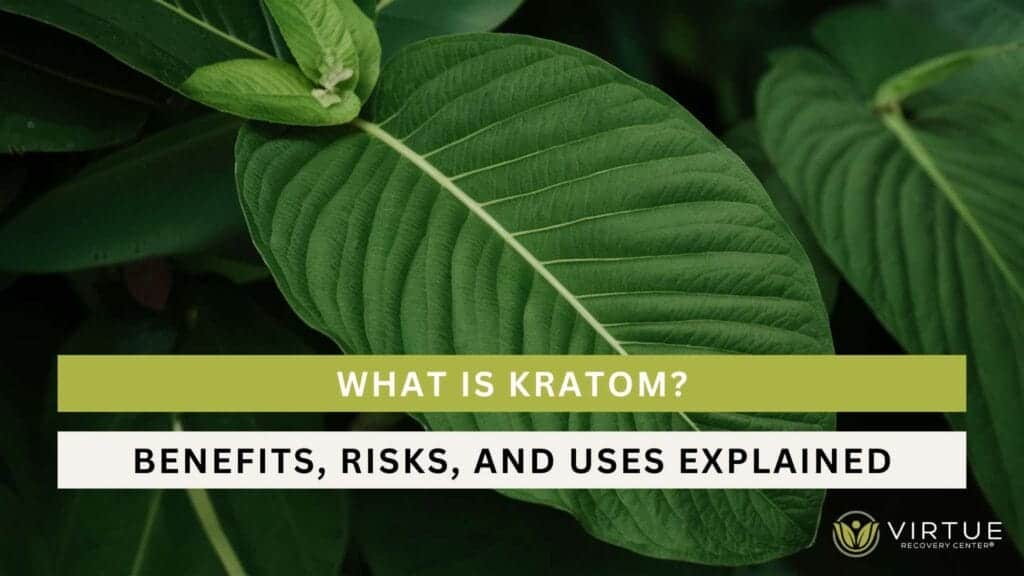Key Takeaways
- Kratom is a tropical tree native to Southeast Asia, known for its psychoactive properties.
- Kratom use can have both potential benefits and significant risks, including dependence and withdrawal.
- The FDA has issued warnings about the safety and quality of kratom products.
- Understanding the effects of kratom is essential for making informed decisions about its use.
- More research is needed to determine whether kratom is safe and effective for medicinal purposes.
Introduction to Kratom
Kratom, a tropical tree native to Southeast Asia, has garnered significant attention for its psychoactive properties and potential medicinal uses. Known scientifically as Mitragyna speciosa, kratom leaves have been traditionally used for centuries in countries like Thailand and Malaysia. Today, kratom is marketed as a dietary supplement in many parts of the world, including the United States, despite growing concerns about its safety and potential for addiction.
What is Kratom?
Origins and History
Kratom has a long history of traditional use in Southeast Asia. Indigenous people have used kratom leaves for their stimulant effects to combat fatigue and improve productivity. Additionally, kratom has been utilized in folk medicine to relieve pain and manage opioid withdrawal symptoms.
Traditional Uses
Traditionally, kratom leaves are chewed, brewed into tea, or crushed into a powder and ingested. The effects of kratom can vary depending on the dosage and strain, ranging from stimulant-like effects at lower doses to sedative and pain-relieving effects at higher doses.
The Problem with Kratom
The big problem with kratom right now is how easily it is obtainable since it is legal in so many states. What’s being abused is kratom extract which is very expensive in relation to standard powder and much, much stronger. There are a number of states that have recently either banned kratom or are planning to. Kratom is also not a scheduled drug at all, meaning it can easily be found in gas station shops or purchased online.
How Kratom Works
Active Compounds
The primary active compounds in kratom are mitragynine and 7-hydroxymitragynine. These alkaloids interact with the brain’s opioid receptors, producing effects similar to both stimulants and opioids. This dual action is what makes kratom both intriguing and controversial.
Interaction with Opioid Receptors
Kratom’s interaction with opioid receptors in the brain is responsible for its pain-relieving effects and its potential for addiction. By binding to these receptors, kratom can mimic the effects of opioids, leading to euphoria, pain relief, and, unfortunately, dependence.
Different Strains and Colors of Kratom Leaves
Red Vein Kratom
Red vein kratom is known for its calming and sedative effects. It is often used for pain relief and to help with sleep. However, due to its strong interaction with opioid receptors, red vein kratom carries a higher risk of dependence and withdrawal symptoms.
Green Vein Kratom
Green vein kratom offers a balance between the stimulating and sedative effects of kratom. Users often report enhanced alertness, increased energy, and moderate pain relief. This strain is popular for its versatility but still carries risks associated with kratom use.
White Vein Kratom
White vein kratom is primarily used for its stimulant effects. It is known to boost energy, improve mood, and enhance focus. While it may be less likely to cause sedation, white vein kratom can still lead to dependence and has its own set of risks.
Risks and Side Effects of Kratom Substance Use
Dependence and Withdrawal Symptoms
One of the significant risks associated with kratom use is the potential for dependence. Users who regularly consume kratom may experience withdrawal symptoms similar to those of opioids, including irritability, muscle aches, insomnia, and mood swings.
FDA Warnings and Health Risks
The Food and Drug Administration (FDA) has issued warnings about the safety and quality of kratom products. There are concerns about contamination, mislabeling, and the potential for serious health risks, including liver damage and seizures.
Potential for Contamination
Kratom products available in the market are often not regulated, leading to potential contamination with harmful substances. This lack of regulation increases the health risks for users who consume these products, sometimes unknowingly.
Impact on Mental Health and Well-being Related to Kratom
Anxiety and Depression
While some users claim that kratom helps manage anxiety and depression, there is limited scientific evidence to support these claims. Kratom use can sometimes exacerbate mental health issues, leading to increased anxiety and depressive symptoms.
Impact on Overall Mental Health
The long-term effects of kratom on mental health are not well understood. However, the potential for dependence and withdrawal can negatively impact overall mental well-being, making it crucial to approach kratom use with caution.
Health Risks and Potential for Addiction
Risk of Addiction and Dependence
Kratom has a significant potential for addiction due to its interaction with opioid receptors. Regular users may develop a tolerance, requiring higher doses to achieve the same effects, which increases the risk of dependence.
Effects of Long-Term Use
Long-term kratom use can lead to several health issues, including liver damage, kidney problems, and an increased risk of developing substance use disorders. Chronic use can also lead to cognitive impairments and other serious health concerns.
Overdose and Severe Reactions
Although kratom overdoses are rare, they can occur, especially when combined with other substances. Symptoms of a kratom overdose include extreme sedation, confusion, seizures, and, in severe cases, coma or death.
Legal and Regulatory Status
FDA and DEA Positions
Both the FDA and the Drug Enforcement Administration (DEA) have expressed concerns about kratom’s safety. The FDA has warned consumers about the risks of kratom, while the DEA has considered classifying it as a Schedule I controlled substance due to its potential for abuse.
Current Legal Status in the U.S.
The legal status of kratom varies by state in the U.S. While some states have banned its sale and use, others allow it under specific regulations. It is important to stay informed about the laws in your area if you are considering using kratom.
Here are some of the key states involved in these legislative efforts:
- Alabama – Kratom has been classified as a Schedule I controlled substance since 2016, making it illegal to possess, sell, or use.
- Arkansas – Kratom is also classified as a Schedule I controlled substance, banning its sale and use.
- Indiana – Kratom has been identified as a synthetic drug and is regulated under synthetic controlled substance laws.
- Rhode Island – The state has classified kratom as a controlled substance, making its sale and use illegal.
- Vermont – Kratom is classified as a controlled substance, prohibiting its sale and use.
- Wisconsin – Kratom is classified as a Schedule I controlled substance, and there are ongoing legislative efforts to further regulate its sale and distribution.
In addition to these states, several others are considering new regulations or bans, including Connecticut, Georgia, Illinois, Kansas, Massachusetts, Michigan, Minnesota, New Jersey, New York, Ohio, and Pennsylvania. These states are working on various legislative measures to either restrict the sale of kratom to minors, regulate its purity and labeling, or outright ban its use and distribution.
Uses of Kratom Compounds
As a Dietary Supplement
Kratom is marketed as a dietary supplement, with claims that it can boost energy, improve mood, and relieve pain. However, due to the lack of regulation, these claims are not always backed by scientific evidence.
Recreational Use
Some people use kratom recreationally for its psychoactive effects. While it may provide a temporary sense of euphoria, the risks associated with recreational use, including addiction and health complications, are significant.
Kratom Extracts and Products
Kratom is available in various forms, including powders, capsules, and extracts. These products can vary in potency and purity, increasing the risk of overdose and adverse reactions.
Conclusion
Kratom is a complex and controversial herbal supplement with both potential benefits and significant risks. While it may offer some relief for conditions like chronic pain and opioid withdrawal, the potential for addiction and severe health risks cannot be ignored. It is crucial to approach kratom use with caution and to seek professional advice before incorporating it into any treatment plan. If you or a loved one is struggling with addiction, give us a call at 866-338-5779.
FAQs
What is kratom?
Kratom is a tropical tree native to Southeast Asia, known for its psychoactive properties and traditional medicinal uses.
What are the different strains and colors of kratom leaves?
Kratom leaves come in various strains and colors, including red vein, green vein, and white vein, each with different effects.
What risks are associated with kratom use?
Risks include dependence, withdrawal symptoms, potential contamination, and severe health risks such as liver damage and seizures.
How does kratom impact mental health and well-being?
Kratom use can potentially exacerbate mental health issues like anxiety and depression and lead to dependence and withdrawal symptoms.
Is kratom legal in the United States?
The legal status of kratom varies by state, with some states banning its sale and use and others allowing it under specific regulations.
Is kratom considered an opioid?
Kratom is not considered a traditional opioid, but it contains compounds that interact with opioid receptors in the brain, producing similar effects to opioids. People who use kratom often seek its pain-relieving and mood-enhancing properties.
What does kratom deplete?
Regular kratom use can deplete the body of essential nutrients such as magnesium and calcium. This depletion can contribute to adverse health effects over time.
Can kratom lower testosterone?
Yes, taking kratom has been associated with lowering testosterone levels in some users, potentially leading to hormonal imbalances and other related health issues.
Can kratom cause low potassium?
There is no strong evidence linking kratom use to low potassium levels specifically, but its impact on overall nutrient balance could indirectly affect potassium levels.
Can kratom cause liver problems?
Kratom can cause liver problems, including liver toxicity and damage, in some users. Kratom exposure has been linked to serious side effects affecting liver health.
What does kratom interact with?
Kratom can interact with various medications and substances, including other opioids, antidepressants, and recreational drugs, potentially leading to adverse effects and drug interactions.
Can kratom help with withdrawal symptoms?
Kratom has been reported by some users to help alleviate withdrawal symptoms from opioids, but its use for this purpose is not well-regulated and carries risks of dependency and other adverse effects.
Will kratom help with pain?
Kratom can help with pain relief due to its interaction with opioid receptors, making it popular among people who use kratom for chronic pain management. However, this benefit comes with the risk of dependency and other health effects.
Can kratom cause yeast infections?
There is no direct evidence linking kratom use to yeast infections, but compromised immune function due to nutrient depletion and other factors could potentially increase susceptibility to infections.
Do people experience kratom withdrawal?
Yes, kratom users can experience withdrawal symptoms similar to those of opioids, including irritability, anxiety, nausea, and cravings, indicating its potential for dependency.
How do kratom compounds work in the brain?
Kratom compounds, primarily mitragynine and 7-hydroxymitragynine, work in the brain by binding to opioid receptors, influencing pain perception, mood, and anxiety, similar to how traditional opioids function.
How does kratom use affect pregnancy?
Kratom use during pregnancy can have adverse effects, potentially leading to neonatal abstinence syndrome and other health complications for the newborn, similar to opioid exposure.
How does kratom affect the body?
Kratom affects the body by interacting with the central nervous system to produce pain relief, euphoria, and sedation, but it can also lead to serious side effects like liver damage, hormonal imbalances, and dependency. Regular kratom use can result in a range of health effects, both beneficial and adverse, depending on the dosage and frequency of use.
What Are the Risks and Benefits of Using Benzos Compared to Kratom?
When it comes to understanding benzodiazepines effects compared to Kratom, there are both risks and benefits to consider. While benzodiazepines can offer quick relief for anxiety and insomnia, they also come with the potential for addiction and severe withdrawal symptoms. On the other hand, Kratom is a natural alternative with potential for abuse and unknown long-term effects.
Resources
https://www.dea.gov/sites/default/files/2020-06/Kratom-2020_0.pdf
https://nida.nih.gov/research-topics/kratom
https://www.webmd.com/vitamins/ai/ingredientmono-1513/kratom
https://www.mayoclinic.org/diseases-conditions/prescription-drug-abuse/in-depth/kratom/art-20402171
https://www.fda.gov/news-events/public-health-focus/fda-and-kratom
https://www.deadiversion.usdoj.gov/drug_chem_info/kratom.pdf








